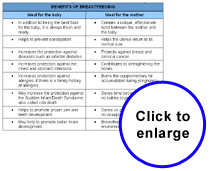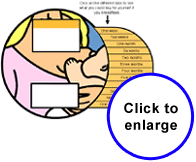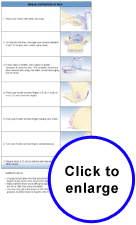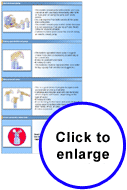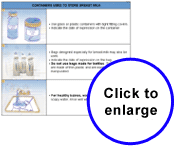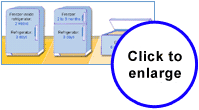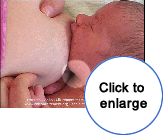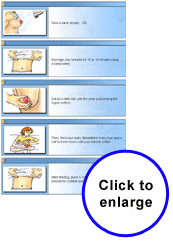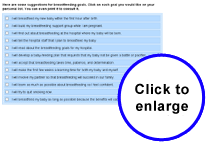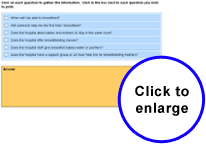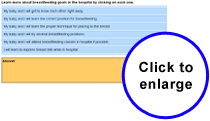Choosing to Breastfeed
INTRODUCTION
You are pregnant! This is the ideal time to decide how you want to feed your baby. Because milk will be the main source of food for your baby during the first year, it is important that you are well-informed before deciding on the method you will use.
Breast milk is made especially for your baby. It contains all the necessary ingredients for the growth and development of your newborn. It is convenient, at the right temperature and takes no preparation. It is impossible to reproduce or imitate your breastmilk.
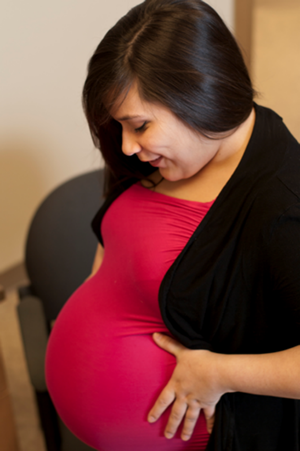
Your family and friends may give you a great deal of advice about breastfeeding. They will share their good or bad personal experiences. Not everyone believes that breastfeeding is the best thing to do. You may have mixed feelings. What should I do? Inquire about the facts and decide what is best for you and your baby.
A. BREASTFEEDING - NOTHING COMPARES!
Being successful and happy with breastfeeding depends on the confidence you have in your capacity to breastfeed. Even though breastfeeding is "natural", learning to breastfeed is a step by step process for both mom and baby, and can be challenging. The first six weeks are when most learning takes place. Breastfeeding becomes easier with time.

a. Benefits of Breastfeeding
b. Concerns and Myths Surrounding Breastfeeding
New parents have many questions about breastfeeding. Will I be able to breastfeed? Will I have enough milk? Will my partner feel left out?

Test Your Knowledge
|
|
This exercise will help you verify your knowledge about breastfeeding. You will also find answers to some of your questions.
Click on the button that corresponds to the correct answer and check your answer by clicking on the "Check" button.
|
1 |
Most women are able to breastfeed. |
|
2 |
Mothers with small breasts produce less milk than mothers with big breasts. |
|
3 |
Women with flat or inverted nipples cannot breastfeed. |
|
4 |
Breastfeeding causes the breasts to "sag". |
|
5 |
Breastfeeding takes a lot of time. |
|
6 |
A mother who is breastfeeding must watch what she eats. |
|
7 |
Mothers who smoke can breastfeed their babies. |
|
8 |
A woman who is breastfeeding can become pregnant. |
|
9 |
If a woman breastfeeds, her partner is excluded from providing care to the baby. |
|
10 |
It is possible to continue breastfeeding even after returning to work or to school. |
c. Risks of Not Breastfeeding
The benefits of breastfeeding for both the mother and the child are being recognized more and more. Have you ever thought about the risks to you and your baby’s health associated with not breastfeeding? The following list will help you to discover the most common risks mentioned in the literature. Food for thought...
- Increased risk of allergy and asthma
- Reduced cognitive development
- Increased risk of acute respiratory disease
- Increased risk for infection from contaminated formula
- Increased risk of childhood cancers
- Increased risk of obesity and diabetes
- Increased risk of cardiovascular disease
- Increased risk of gastrointestinal and ear infections
- Increased risk of Sudden Infant Death Syndrome*
- Increased risk of breast, ovarian and endometrial cancer for mothers
- Increased risk of osteoporosis and rheumatoid arthritis for mothers
- Increased risk of maternal diabetes
Reference:
INFACT Canada. 14 Risks of Formula Feeding. Retrieved from: http://www.infactcanada.ca/pdf/14-Risks-Small.pdf
INFACT Canada. 2006. Risks of Formula Feeding. Retrieved from: http://www.infactcanada.ca/RisksofFormulaFeeding.pdf
1. Expression of Milk
During the first weeks you may have to express milk if:
- your breasts are too hard for the baby to latch.
- you want to feed your baby with breast milk when you are apart.
- you need to increase your milk production.
This is how to express milk manually.
Most mothers do not need a breast pump. If you do need a breast pump, there are a variety of pumps available for rent or purchase from lactation consultants, hospitals, medical supply outlets, drug stores and some children's stores. Lactation consultants provide instructions and support for the pumps they supply. You can consult a public health nurse at 613-580-6744, a Lactation Consultant, La Leche League, a nurse or midwife about which pump is best for you. The type of pump you select depends on what you intend using it for.
 |
No matter which type of pump you select, you must always follow the instructions that come with the pump. |
Here are a few tips if you are planning on purchasing a breast pump.
2. Storing and Thawing of Breast Milk
B. PREPARING TO BREASTFEED
Once you decide to breastfeed, you can begin to prepare yourself. The time to do this is now while you are pregnant. Successful breastfeeding depends mostly on the confidence you have in your ability to breastfeed. An appropriate preparation is essential in order to develop this confidence. Receiving adequate support, even during pregnancy, will help your confidence when breastfeeding.

a. Changes Occurring in Your Breasts
Your breasts were getting ready to breastfeed even before you thought about being a mother. Milk glands start to grow during the teenage years.
During pregnancy, the breast, areola, and nipple get bigger. The nipple and the areola become darker. The alveoli and the ducts increase in number and grow in size.
b. The Breast and How It Works
You will notice a big change in your breasts when the baby is born. Once the placenta leaves the body, hormones stimulate the alveoli to produce milk. The milk passes through the lactiferous ducts and is stored in the small reservoirs situated under the areola causing the breasts to swell. You may feel that your breasts are full or even a little tight. If you breastfeed often, these sensations tend to go away.
When the baby is positioned correctly, movements of the mouth squeeze the reservoirs located just under the areola. The milk flows through several small openings located on the tip of the nipple. The position of the baby's mouth on the breast is very important to assure that the baby is breastfeeding well.
The following animation illustrates the production of milk.

c. Breastfeeding Positions
There are several breastfeeding positions. Follow these suggestions for each position.
- Your back and arms must be well supported. A pillow behind your back and under your arms will help.
- The baby's body and head are raised up to your breast. Place a pillow under the baby.
- The baby's chest must face and touch your chest. Place the baby on his/her side except for the football position.
- For the football position, place the baby on his\her back or slightly turned towards the breast.
- Your baby's nose must face the nipple. Bring the baby towards you instead of leaning forward or pushing your nipple into the baby's mouth.
Remember that it is important to change breastfeeding positions and to offer both breasts at every feeding.
The following pictures illustrate the main breastfeeding positions.
|
Alternate Arm Cradle Hold This position works well, if you are learning to breastfeed:
|
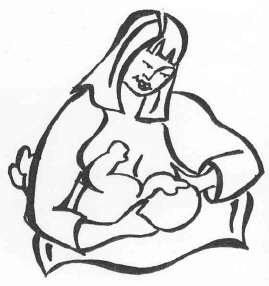 |
|
Football Hold This position works well:
|
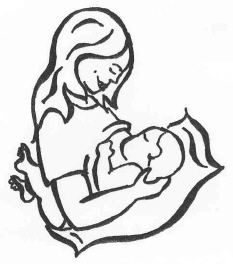 |
|
Cradle Hold This position works well:
|
 |
|
Side-Lying Hold This position works well:
|
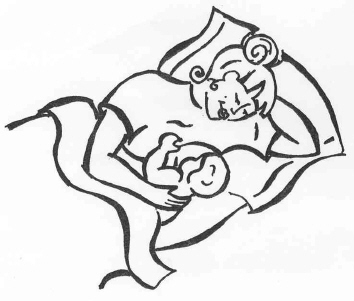 |
d. Learning to Breastfeed
Begin breastfeeding as soon as possible after the delivery. The baby is most awake and ready to learn how to breastfeed during the first two hours after birth. Breastfeeding as soon as possible after delivery will favour skin to skin contact with your baby and will help you produce more milk.
Once you are in a comfortable position, you are ready to offer your breast to your baby. The cross cradle position may be the best position for the learning period.
Babies often suck better if their skin is in contact with the mother's skin. They will keep warm from being skin to skin with you. In the beginning, undress the baby down to just their diaper prior to feeds to help keep baby awake at the breast. Some infants find the breast and latch on correctly from the first tries. Others need help. The following pictures provide a few tips to help your baby accept the breast correctly.
The following video shows a baby well positioned on the breast.
Feed the baby before he or she gets upset or cries loudly. Crying is a late sign of hunger. The baby will show signs of hunger long before starting to cry.
Your baby can
- have rapid eye movements under the eyelids when he/she begins waking up to drink.
- make sucking and licking movements with his/her mouth.
- put his/her hand in his/her mouth.
- stretch and become more agitated.
- make small noises.

A sign that the baby is hungry.
e. Skin-to-Skin Contact
Skin-to-skin contact involves placing the baby wearing only a diaper, tummy down on his/her mother's bare chest immediately after birth and well into the firts month. Baby may be covered lightly with a blanket. Your partner or support person can also do skin-to-skin to know, comfort and nurture your baby.
Benefits:
- Strengthens the mother-baby relationship;
- Helps regulate the baby's body temperature, respirations and heart rate;
- Promotes better breastfeeding;
- Helps regulate the baby's blood sugar;
- Provides pain relief to baby during painful procedures;
- Encourages longer duration of breastfeeding, on average by an additional six weeks.
- The benefits of skin-to-skin for bonding, soothing and breastfeeding continue well after the newborn period.
- Premature babies also benefit from skin-to-skin. Sometimes this is called Kangaroo Care.

f. Infant Feeding Cues:
Babies should be fed when they cue or indicate hunger. Crying is a late cue or indicator of hunger. Breastfeeding is much easier for both mother and baby if you are able to pick up on baby's early hunger cues.
Sample video from "Breastfeeding : Bringing baby to the breast" from http://www.videoallaitement.org/english.html
Common infant hunger cues include:
Early:
- Increased alertness, moving during sleep or having REM sleep
- Smacking or licking lips
- Opening and closing mouth
- Sucking on lips, tongue, hands, fingers, toes, toys, or clothing.
Active:
- Rooting around on the chest of whoever is carrying him
- Trying to position for nursing, either by lying back or pulling on your clothes
- Fidgeting or squirming around a lot
- Hitting you on the arm or chest repeatedly
- Fussing or breathing fast
Late:
- Moving head frantically from side to side
- Crying
Test Your Knowledge
|
|
The following exercise will help you acquire knowledge to make breastfeeding successful.
Click on the button that corresponds to the correct answer and check your answer by clicking on the "Check" button.
|
1 |
It is important to begin breastfeeding as soon as possible after the birth of your baby. |
|
2 |
You must breastfeed every four hours the first few days. |
|
3 |
Do not give a pacifier or bottle to a breastfed baby. |
|
4 |
Most mothers need help to learn how to breastfeed. |
|
5 |
You must always give water to breastfed babies. |
g. Signs that the Baby Is Breastfeeding Well
New mothers often wonder if their baby is drinking enough milk. Although you cannot check the quantity of milk the baby is drinking, there are signs that indicate if the baby is drinking enough.
1. The Baby's Suckling
At the beginning of the feeding, your baby's suckling will be shallow and quick. Once the milk begins to flow, the baby's suckling should become deep and slow. At one point there should be a pause and the baby should open its mouth wide. This is when the mouth fills with milk. The longer this pause, the more milk the baby gets.
You may :
- Feel some initial pain for the first few sucks which should go away. If it continues, the baby may not be latched or positioned well. Ensure to receive professional help to assist to correctly breastfeed your baby.
- Hear the baby swallow.
The next video shows a baby breastfeeding well.
Sample video from "Breastfeeding : Bringing baby to the breast" from http://www.videoallaitement.org/english.html
2. Number of Wet and Soiled Diapers
By counting the number of wet and soiled diapers, you can check if your baby drinks enough milk.
- at 1 day old has at least 1 wet diaper and at least 1 to 2 sticky dark green/black stools
- at 2 days old has at least 2 wet diapers and at least 1 to 2 sticky dark green/black stools. ** This is easier to notice urine in cloth diapers. A facial tissue can be placed inside disposable diapers, if you are not sure.
- at 3 days old has at least 3 heavy wet diapers and at least 3 brown/green/yellow stools. Occasional “red brick coloured” staining is normal until day 3.
- at 4 days old has at least 4 heavy wet diapers and at least 3 brown/green/yellow stools.
- at 5 days and older, as the milk supply increases, baby has at least 6 heavy wet diapers and at least 3 large soft yellow seedy stools per day.

A wet diaper is equivalent to 2 tablespoons or 30ml, and a heavy wet diaper is equivalent to 4-5 tablespoons or 60-75 ml.
3. Weight Gain
The weight gain is a good indication that the baby is drinking enough milk. Here are a few clues.
- Most breastfed babies will lose up to 7 percent of their birth weight during the first three days after birth.
- Your baby should gain at least five to eight ounces (140 to 224 grams) per week during the first three months and at least 1 pound (16 oz or 448 g) per month between the third and the sixth month.
- Your baby should have returned to his/her birth weight by the second week of age.
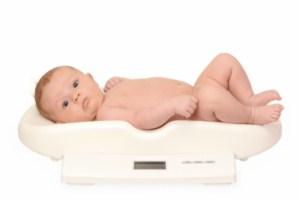
4. Other Signs
There are other signs to indicate if the baby is drinking enough milk. Observe the following clues:
- Your baby has a loud cry and moves a lot.
- Your baby's mouth is wet and pink.
- Your baby's eyes look bright and awake.
- Your baby comes off the breast looking relaxed and sleepy.
- Your breasts feel softer and less full after breastfeeding.
|
Ask for help immediately if your baby does not seem to be breastfeeding well. |
h. Breast Care
There is no special care required for your breasts during pregnancy. Good daily hygiene is sufficient. The Montgomery tubercules (glands) situated under the areola are responsible to prepare your breasts for breastfeeding. To support your breasts, wear a bra that fits well; preferably without underwire.

1. General Breast Care
Basic care is important during breastfeeding
- Wash your breasts daily. Avoid putting soap on your nipples, especially if they are sore. Soap may dry your nipples and cause them to crack.
- Wear a well-adjusted bra that is not too tight. Do not wear a bra with underwires.
- After breastfeeding, express some breast milk into the nipples and the areolas in order to protect the skin. Allow the milk to dry before putting on your bra.
2. Hard Breasts
The breasts may become hard or engorged the first days after birth. This engorgement is caused by an accumulation of milk in the breasts. This happens during the inflow of milk usually three to four days after the birth of your baby. If your breasts become hard, the baby may have trouble feeding. The hardness should only last 1-2 days. Here is some advice to help soften your breasts.
During the first weeks, you may have to express breast milk if your breasts are too hard for the baby to latch on.
You will find more information on expressing breast milk in Module 8 entitled "Healthy Family".
 |
Ask for help immediately if you:
|
3. Sore Nipples
The nipples may become tender during the first few days birth. This situation should improve daily. Breastfeeding should not be painful. Check the following table if you have sore nipples.
 |
Ask for help immediately if your nipples are sore even though the baby is well-positioned and feeding properly. |
i. Setting Goals for Breastfeeding
The ideal time for the first feeding is within the first two hours following birth. Breast milk is all the baby needs during the first six months. After six months, begin to introduce solid foods while continuing to breastfeed for up to two years and beyond.

Now is a good time to set your own goals for breastfeeding. You have the natural ability to breastfeed, but you must learn how to do it correctly.
By setting goals, you are learning what to do. You can also decide how you are going to do it. By setting your goals in advance, you can then decide how you will achieve them.
j. Creating Breastfeeding Support
Although breastfeeding is the natural way to feed your baby, that doesn't mean that you will know how to do it right away. Most mothers need information and support while breastfeeding especially during the first two months.
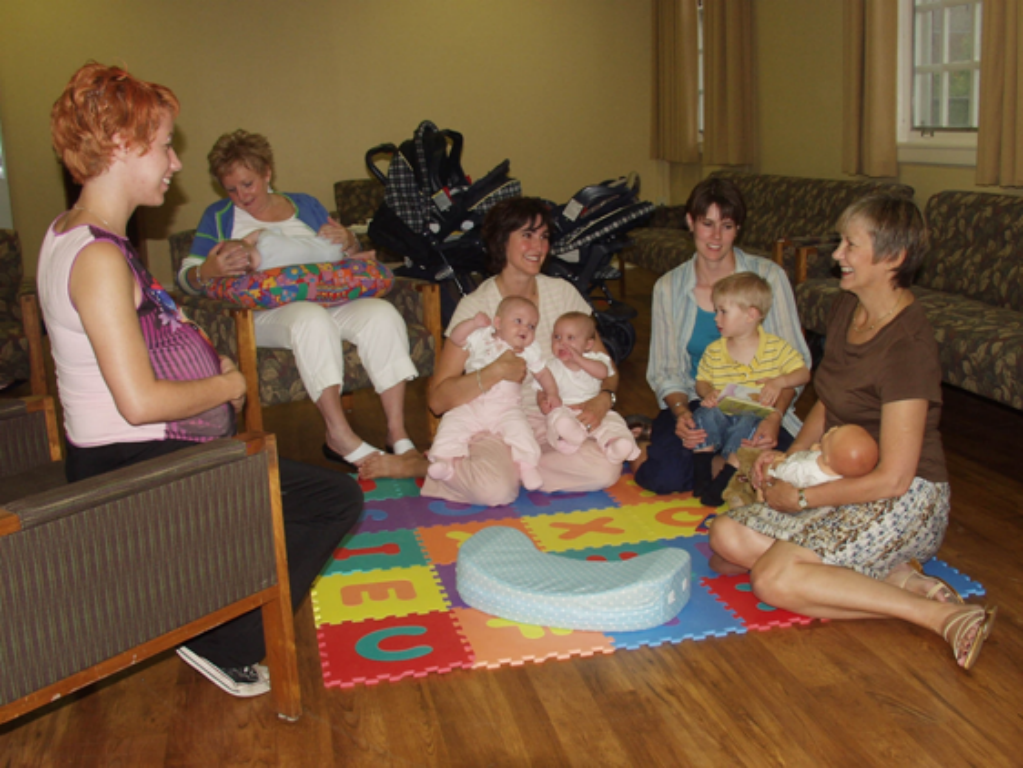
1. How Can a Breastfeeding Support Network Help Me?
It is good to plan your support network ahead of time. Think about friends, members of your family, professionals, and any other person who will be able to help. It is also a good idea to determine how these people can support you during breastfeeding.
With the help of a support group, you will have
- someone to talk to about breastfeeding and from whom you can get help either in person or by phone.
- someone in whom you will be able to confide anytime during the day or night; but most often during the night.
- someone who will check up on you to see how you are making out.
- someone who will take care of the baby while you take a bath, go to the hairdresser, or simply have a rest.
- someone who will prepare some meals, do the cleaning, or get the groceries.
- someone who will care for the other children if you have any. The other children, depending on their ages, can also be involved.
- someone who will invite you, your baby, and your family for a meal or an outing.
- someone who will babysit while you and your partner go out.
Keep in mind that your family and friends will offer advice whether you have asked or not. Some advice will be helpful, some not. Don't be afraid to ignore the advice that is not good for you. Thank them and do what you think is best for you and your baby.
2. Who Can Be Part of My Support Network?
Now is time to create this support group so you will be ready when your baby is born. Here are a few suggestions.
- Find one or two mothers who have enjoyed breastfeeding and who live near you. Ask them if they will give you moral support and help you if necessary.
- Talk to your partner about sharing the workload once the baby arrives and explain why you will need his help.
- Find out if there is a support group in your area. If possible, attend one or two meetings before the baby is born. This will allow you to establish contacts with mothers who have already lived the breastfeeding experience.
- Find other mothers to talk with and who will agree to exchange child care services. Find out how you can give each other time off when you need it.
- Check to see if there are community groups or a Parent Resource Center in your area that feature day nursery services, mother-baby groups, or exercise programs you can join.
- Talk about breastfeeding with your public health nurse. There are Breastfeeding Support Drop-ins in the community to assist you with your breastfeeding.
C. MEDICATIONS AND MOTHER'S MILK
An appropriate preparation is essential in order to make the safest choices for you and your baby. Alcohol can harm your baby's health. Most medications are safe while breastfeeding. It is important to understand how Alcohol and Medications enter into the breastmilk and to your baby before making the best decisions. To be sure always check with your Health Professional.
a. Alcohol
Alcohol easily passes into the mother's breastmilk, with the level being close to what is in the mother's blood supply. There is no known safe amount of alcohol exposure for a baby from breastmilk! The safest choice is not to drink alcohol while you are breastfeeding.If you have an occasional glass of alcohol, it is recommended to consume it after feeding your baby and to wait about two to three hours before feeding.General guideline: it takes approximately 2-3 hours for one standard drink of alcohol to clear from the mother's breastmilk. Heavy alcohol consumption should be avoided. The effects of alcohol on baby are not well studied.

b. Medications
Most medications are safe while breastfeeding and most do enter into the breastmilk in small amounts. Very few medications the baby is exposed to in the breastmilk have caused side effects. Risks of not breastfeeding the baby are often higher than the risk of the mom taking the medication while breastfeeding. Important to ensure when a health care provider is prescribing medications to the breastfeeding mother, that they are aware she is breastfeeding.

Further information can be found at:
Organization of Teratology Information Specialists (OTIS): 1-866-626-6847 www.otispregnancy.org
Dr Jack Newman's website: www.nbci.ca
D. BREASTFEEDING IN THE HOSPITAL
Not all hospitals offer the same support to mothers who want to breastfeed. Find out if there is support for breastfeeding at the hospital where your baby will be born. Ask about this when you are pregnant so you will know what to expect. All New-Brunswick hospitals have lactation consultants that you can see during your hospital stay after the birth of your baby.

a. Questions to Ask before Labour
One way to prepare for breastfeeding is to ask questions. If possible, question the hospital staff before your due date. Here is a list of questions you can ask the staff at the hospital where your baby will be born. You can print the list and bring it with you to the hospital so you can discuss with the nurses during labour.
b. Goals for Breastfeeding in the Hospital
c. Breastfeeding Plan
Test Your Knowledge
|
|
Congratulations! By completing this module, you have learned how to prepare to breastfeed your baby. The following exercise will allow you to verify if you are ready to begin the wonderful experience of breastfeeding.
Click on the button that corresponds to the correct answer and check your answer by clicking on the "Check" button.
|
1 |
The newborn should be placed to the breast |
|
2 |
Among the following people, who would be best suited to be part of your breastfeeding support group? |
|
3 |
How long is it recommended to breastfeed exclusively? |
|
4 |
What is the best thing your partner can do to help you breastfeed? |
|
5 |
While breastfeeding during the first days following birth it is better to |
|
6 |
While in the hospital, it is better to |
|
7 |
When is the best time to get ready for breastfeeding? |
|
8 |
Which among the following statements is not a good prenatal breastfeeding goal? |
CONCLUSION
Deciding to breastfeed is the best choice because breast milk is the natural food for your baby. In this module you have learned how to prepare yourself well for a successful breastfeeding experience for you and your family.
The special bond between you and your baby will get stronger every day because of breastfeeding. The more experience you acquire the more comfortable you will become and the more breastfeeding will be enjoyable. Your baby will be grateful for life!

For more breastfeeding information and support visit Ottawa Public Health's website.
